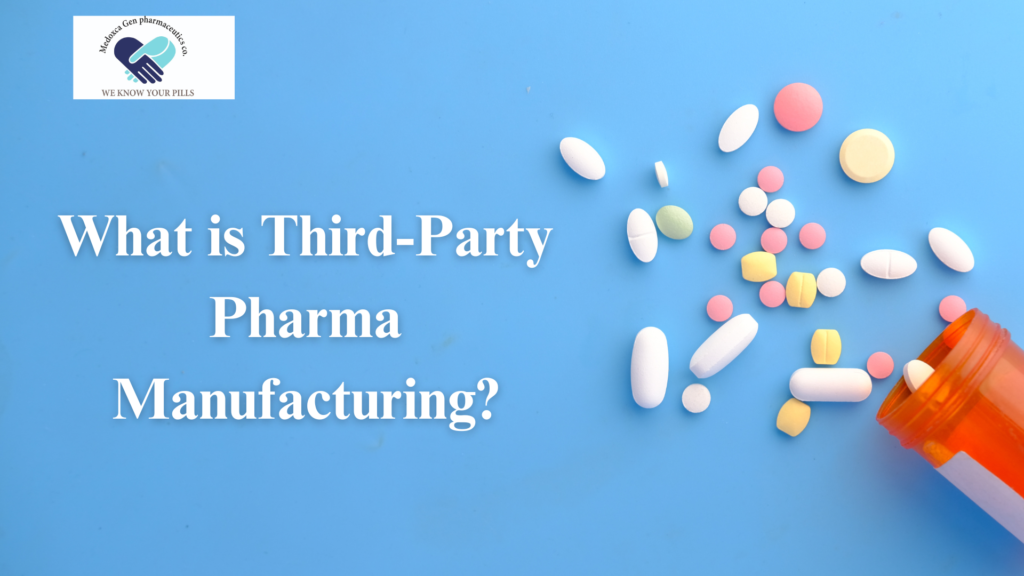Introduction
The pharmaceutical industry is one of the fastest-growing sectors globally, driven by the increasing demand for medicines and healthcare products. Among various business models in this industry, third-party pharma manufacturing has gained significant popularity. This model allows pharmaceutical companies to outsource manufacturing of their medicines to specialized manufacturers, enabling them to focus on branding, marketing, and distribution.
In this blog, we will explore the concept of third-party pharmaceutical manufacturing, its benefits, challenges, and the steps involved in selecting the right contract manufacturing partner.

Third-Party Pharma Manufacturing?
Third-party pharma manufacturing, also known as contract manufacturing, is a business model where pharmaceutical companies outsource drug manufacturing to specialized pharmaceutical manufacturers. Instead of setting up their own pharmaceutical production units, companies collaborate with GMP-certified pharma manufacturers who produce drugs under their brand name.
This model allows pharmaceutical brands to focus on their core competencies, such as pharmaceutical research, marketing, and sales, while leveraging the expertise of third-party medicine manufacturers for large-scale production. It is widely used by both small and large pharma companies worldwide.
How Third-Party Pharma Manufacturing Works
The process of third-party pharma manufacturing involves several steps, from selecting a reliable pharma contract manufacturer to ensuring regulatory compliance. Below is a step-by-step breakdown of how this model operates:
- Identifying the Manufacturer – A company looking to outsource drug production must identify a reliable and certified manufacturer that meets WHO-GMP standards.
- Finalizing the Product List – The pharmaceutical company and the third-party pharma manufacturer agree on the pharmaceutical formulations, including dosage forms, API sourcing, and packaging requirements.
- Agreement & Documentation – Both parties sign a contract outlining the terms and conditions, including bulk drug manufacturing, pricing, and delivery schedules.
- Procurement of Raw Materials – The contract manufacturer sources high-quality active pharmaceutical ingredients (APIs) required for production.
- Manufacturing Process – The third-party drug manufacturer follows Good Manufacturing Practices (GMP) to ensure quality assurance.
- Quality Control & Testing – The medicines undergo regulatory quality checks before being approved for final packaging.
- Packaging & Labeling – The finished products are labeled as per the pharma company’s branding and drug regulatory guidelines.
- Final Inspection & Dispatch – The final batch is inspected, approved, and dispatched to the pharmaceutical brand for distribution.
Benefits of Third-Party Pharma Manufacturing
Many pharmaceutical companies prefer third-party medicine manufacturing due to the numerous advantages it offers. Here are some key benefits:
1. Cost-Effectiveness
Setting up a pharmaceutical manufacturing plant requires significant investment in infrastructure, equipment, and skilled labor. Third-party pharmaceutical production eliminates these expenses, making it a cost-effective pharma business model.
2. Focus on Core Business Activities
Pharmaceutical brands can concentrate on pharma product development, branding, and sales while the contract manufacturer handles medicine production. This allows companies to expand their pharma business.
3. High-Quality Production
Reputed third-party pharma manufacturers adhere to WHO-GMP, ISO, and FDA guidelines, ensuring that the medicines produced meet global pharma quality standards.
4. Scalability
Pharmaceutical contract manufacturing enables companies to scale up production without worrying about infrastructure expansion. Bulk medicine manufacturing caters to growing market demands.
5. Faster Time-to-Market
Since third-party medicine manufacturers have ready-to-use production facilities, pharma brands can launch new products in the market quickly.
6. Risk Reduction
Outsourcing pharma manufacturing minimizes financial and operational risks associated with setting up a pharmaceutical production unit.
7. Wide Product Portfolio
Companies can expand their product range without investing in specialized manufacturing facilities by collaborating with multiple contract pharma manufacturers.
Challenges in Third-Party Pharma Manufacturing
Despite its advantages, third-party pharmaceutical contract manufacturing also comes with certain challenges:
1. Quality Control Issues
Ensuring consistent pharma product quality can be challenging when working with external medicine manufacturers.
2. Dependency on Manufacturers
Pharma companies rely on third-party manufacturers for timely medicine production and delivery.
3. Regulatory Compliance
Different countries have varying pharma regulations. Ensuring that the contract manufacturer complies with global pharma regulatory requirements is essential.
4. Intellectual Property Concerns
Sharing pharmaceutical formulations with a third-party drug manufacturer carries risks of intellectual property misuse.
5. Hidden Costs
While third-party pharmaceutical production is cost-effective, companies must be cautious about hidden pharma outsourcing costs.
How to Choose the Right Third-Party Pharma Manufacturer
Selecting the right third-party pharma company is crucial for ensuring product quality, compliance, and timely delivery. Consider the following factors:
1. Certifications & Compliance
Ensure that the third-party pharmaceutical manufacturer holds WHO-GMP, ISO, and FDA approvals.
2. Manufacturing Capacity
The pharmaceutical contract manufacturer should meet bulk order demands and future scalability needs.
3. Product Range
Choose a medicine manufacturer specializing in the required pharma formulations (tablets, capsules, injectables, etc.).
4. Quality Assurance Practices
Evaluate the third-party medicine manufacturing company’s quality control procedures, including batch testing and validation.
5. Reputation & Market Presence
Look for reputed pharma manufacturing partners with positive industry feedback.
6. Pricing & Cost Transparency
Discuss contract manufacturing pricing, hidden costs, and payment terms in advance.
7. Delivery & Supply Chain Management
Timely delivery of pharmaceutical products is essential for seamless pharma distribution.
Future of Third-Party Pharma Manufacturing
The demand for third-party pharmaceutical production is expected to rise due to:
- Increased contract manufacturing pharma collaborations.
- Growth in pharmaceutical exports.
- Rising demand for generic medicines.
- Advancements in biopharmaceutical manufacturing.
Innovations like AI-driven quality control and automated drug manufacturing will further enhance efficiency and compliance.
Conclusion
Third-party pharma manufacturing is a strategic business model that benefits pharmaceutical companies and contract manufacturers. It allows pharma brands to focus on branding and marketing, while ensuring cost-effective, high-quality medicine production.
By understanding the advantages, challenges, and selection criteria of third-party pharmaceutical contract manufacturing, companies can make informed decisions and optimize their pharmaceutical business growth.
